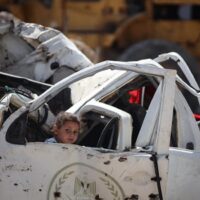According to a special report on Egypt issued this month by the Financial Times, rates of poverty in the country increased between 2000 and 2005, and one in every five Egyptians cannot meet their basic living needs.This, combined with increasing urbanization, rural migration, the gap between supply and demand in the housing market and poor urban planning have all led to a proliferation of informal housing in Egypt. A report by the Egyptian Center for Housing Rights claims that informal housing is growing more rapidly than formal housing and over 20 percent of Egypt’s citizens live in overpopulated areas which lack clean water and sanitation and have no access to services. Three cases which made the headlines in 2007 illustrate the government’s response towards this. On March 20, a fire broke out in Qalet El-Kabsh, a low-income area of Sayyeda Zeinab. The fire destroyed 86 homes and left more than 1,000 people without shelter. Bulldozers accompanied by 20 police vehicles arrived two days later and pulled down houses damaged by the fire. Tear gas was used when residents, who had not been provided with alternate housing, attempted to resist eviction from the ruins of their home.On May 7, police forces again surrounded the area and demanded that those still living on the site leave to allow bulldozers to raze the area to the ground. When some of those left homeless by the fire objected they were attacked by the police. A number of residents were arrested, placed in police vans and dumped in a deserted area of New Cairo’s El Tagmou El Khames.Similar events occurred in Helwan’s Kafr Elw. On Oct. 17, bulldozers arrived in the village at dawn and the police officers accompanying them informed residents that they were to evacuate their homes immediately. They were told that the government was seizing their land. Villagers say that the authorities had given them no prior notification of its plans. Those who refused to leave their homes were assaulted by the police while the village’s men were summoned to Helwan police station and detained there in order to reduce resistance to the evictions.Forty-five homes were eventually destroyed, and the now homeless villagers are living on their ruins. Protests against the evictions are being led by Kafr Elw’s women – men fearing that if they protest they will again be detained. The government claims that some of Kafr Elw’s residents have no legal title to the land, and it is making the same argument to justify the threatened eviction of 5,000 people from Giza’s El-Qorsaya Island. The community of farmers and fishermen are living under the constant threat of expulsion from their land; bulldozers have already started work for what is rumoured to be a golf course or tourist complex.The government claims it may legally evict the islanders despite the fact that some of El-Qorsaya’s families have lived on the island for five generations, and have over 25,000 documents issued by various official bodies acknowledging their presence on the island. In July Al Wayly district began demolishing 21 buildings in Abasseya square to kick-start the construction of Cairo’s third underground metro line, amid the stifled objections of angry residents. Before that the council had cut off electricity and water from all the buildings, where shop owners and some residents objected to not receiving what they consider to be “satisfactory compensation. They claimed that the government devalued the land, offering merely LE 2,000 per square meter. They were forced to either take minimal compensation or move their shops to Nahda, an area affiliated to El Salam District, along the road to 10th of Ramadan City, an area known for harboring criminals and drug addicts.



